Why is it important
At B.Grimm Power, ensuring occupational health and safety in both physical and mental aspects for our employees, contractors and visitors is one of the top priorities. We strive to place the importance on managing workplace health and safety to ensure compliance with laws and regulations as well as the quality and efficiency of power generation, the impact on the community around the power plant, customer confidence and the organisational image to our stakeholders including employees, communities, regulators and partners.
Target and Performance
| 2024 | 2025 | 2030 | ||
|---|---|---|---|---|
| Performance | Target | Target | Target | |
| Lost-Time Injury Frequency Rate (LTIFR)1 | ||||
| Employees3 | 0 | 0 | 0 | 0 |
| Contractors | 0.41 | 0 | 0 | 0 |
| Fatality Rate2 | ||||
| Employees | 0 | 0 | 0 | 0 |
| Contractors | 0 | 0 | 0 | 0 |
1 Lost-Time Injury Frequency Rate calculated from the number of lost-time injury cases per one million hours worked.
2 Fatality Rate calculated from the number of fatality cases per one million hours worked.
3 B.Grimm’s Occupational Health and Safety LTIFR for employees is benchmarked against the Electricity Generation Industry standard (0.05–0.15 LTIFR per 200,000 hours worked), as referenced by the International Council on Mining and Metals (ICMM) and aligned with GRI 403 guidelines. B.Grimm’s current LTIFR remains at 0, which is well below the industry threshold, demonstrating our strong commitment to a safety-first culture in operations.
Management Approach and Strategy
Policy and Commitment
- Strictly monitor and follow up on operations to ensure compliance with applicable laws, regulations, and international standards related to occupational health and safety.
- Apply advanced technologies and innovations to improve operational efficiency and enhance workplace safety.
- Set targets and objectives to reduce risks and minimise social and environmental impacts resulting from resource consumption and pollution, in alignment with our commitment to continuous improvement in occupational health, safety, and environmental management.
- Assess risks that may impact occupational health, safety and environment and establish preventive and corrective measures. Additionally, develop emergency response plans to address, prevent, and control potential damage or hazards.
- Raise awareness and provide training for employees and relevant stakeholders to enhance their skills, knowledge, and understanding of occupational health, safety, and environmental risks and impacts from operations. Encourage employee participation in providing feedback to improve the company’s occupational health, safety, and environmental management system.
- Define the governance structure and responsibilities of committees overseeing the Occupational Health, Safety, and Environment Policy.
Governance Structure
B.Grimm Power has established the governance structure of Occupation Health, Safety and Environment (OSH&E) to ensure effective implementation of the OHS&E policy and to promote continuous improvement through regular reviews. It is the responsibility of all employees, at all levels, to comply with and implement this policy, under the supervision of key relevant management as outlined below:
Responsible for overseeing and approving policies, setting strategic direction, and reviewing the effectiveness of the Occupational Health, Safety, and Environment (OHS&E) management system annually.
Comprising members of the Management Committee and representatives from the OHS&E Working Team, this committee is responsible for developing policies and strategies, overseeing, and regularly monitoring OHS&E performance to ensure alignment with the organisation’s goals and direction.
Consisting of senior management representatives and professional safety officers from both the Bangkok office and power plants, the team is responsible for supervising, monitoring, reporting, and setting operational guidelines on workplace safety, environment, biodiversity conservation, and forest resource protection in compliance with relevant laws and company policies. Monthly meetings are held to communicate policies, engage with key internal and external stakeholders, exchange perspectives, and share initiatives for improving the OHS&E management system. The team also promotes collaboration and awareness among employees, contractors, business partners, regulatory bodies, and other relevant stakeholders.
Strategy
B.Grimm Power has strengthened its occupational health and safety management practices to align with international standards, achieving certification for the Occupational Health and Safety Management System (ISO 45001:2018) across all combined cycle co-generation power plants. Additionally, all power plants have been certified for Environmental Management System (ISO 14001:2015) and Business Continuity Management System (ISO 22301:2019). We regularly conduct risk assessments, monitoring, and performance reviews related to occupational health, safety, and environmental conditions. Furthermore, we actively promote safety activities and communicate relevant policies to employees and stakeholders through the following topics.
Conduct Hazard Identification, Risk Assessment, and Job Safety Analysis for Employees and Contractors
Before commencing any activity, a thorough risk assessment is conducted to evaluate the likelihood and potential impacts. Comprehensive control and preventive measures are established in alignment with the Hierarchy of Controls principle, to ensure that all activities are carried out safely and in accordance with plans and objectives. Supervisors or higher-levels personnel are responsible for conducting risk assessments by evaluating both the likelihood and impact, and categorising the risks into 5 levels: Very High, High, Medium, Low, and Very Low. If a High Risk is identified, stakeholders must establish appropriate control measures or safe work procedures to reduce the risk to a low level before operations commence. Safety measures should follow a structured approach, beginning with Hazard Elimination, followed by Material or Process Substitution, Isolation of Processes or Machinery from Worker, Engineering Controls, and Administrative Controls. Examples of Administrative Controls includes job-specific safety training, health checks before entering the hazardous areas, such as confined spaces, and safety briefings prior to work commencement. Additionally, appropriate Personal Protective Equipment (PPE) must be worn at all times during operations.
The risk assessment is a mandatory step for obtaining work permits within power plant areas. Furthermore, if job hazards or unsafe conditions are identified, employees are required to report them to the OSH&E Committee of the respective power plant, to ensure that appropriate corrective and improvements actions are implemented to maintain a safe working environment.
Worker Supervision and Work Environment Control
- Establish safety rules and operational safety manuals covering employees, contractors, and all relevant personnel within the work area. Supervisors and safety officers are responsible for overseeing and ensuring compliance with safety measures and guidelines. For example, all contractors are required to complete safety training prior to entering the work area, and each contractor must have an on-site supervisor with sufficient safety knowledge throughout the entire duration of the work.
- Require employees and relevant personnel to wear Personal Protective Equipment (PPE) at all times while performing tasks. Regular environmental monitoring and assessments must be conducted in accordance with applicable standards and requirements, for example, noise levels, lighting, and heat exposure.
- Perform regular on-site inspections by supervisors. If a worker is found not following the prescribed procedures or if unsafe conditions are identified that pose potential risks, activities must be immediately halted. The worker must be instructed to comply with the correct safety procedures or the area must be improved to meet safety standards before work may resume.
- Convene Occupational Safety and Health Committee meetings at power plant level and the Bangkok Office level in accordance with legal requirements, to assess, report, and recommend corrective actions or improvement measures for unsafe working conditions. The objective is to reduce the occurrence of accidents and prevent recurrence in those areas.
- Organise OSH&E Working Team meetings to oversee, monitor, report and establish safety procedures. These meetings facilitate communication and discussions with both internal and external stakeholders while also serving as a platform to share perspectives and initiatives for improving occupational health and safety management systems. Additionally, they promote collaboration and continuously raise awareness of workplace safety.
- Perform audits of Occupational Health, Safety, and Environmental Practices at power plant sites through the Corporate SHE Department and the Internal Audit Division to ensure full compliance with B.Grimm Power’s policies, laws, and regulatory requirements.
Incident Reporting and Investigation
Establish a systematic process for reporting accidents or incidents occurring within company premises. Individuals involved in or witnessing such events must follow the emergency response plan and report the incidents to their supervisors as soon as possible. The OHS&E Working Team, in collaboration with relevant parties, will investigate the incident to identify root causes, implement corrective actions and establish preventive measures to avoid recurrence. A designated accident report format is submitted to the relevant government authorities. Additionally, the OHS&E Working Team periodically tracks the progress of corrective actions and improvements, documenting them in B.Grimm Power's centralised Knowledge Sharing Database. This database is accessible to all employees, allowing them to learn from past incidents and share their experiences. Lessons learned from accidents or incidents are shared with employees and contractors through various company communication channels.
Emergency Response
B.Grimm Power places strong emphasis on managing potential risks that could impact business continuity, including fire, chemical spills, floods, and natural gas pipeline leaks. To ensure a systematic and internationally aligned approach to emergency management, risk assessments are conducted, and comprehensive plans, including Business Continuity Plans (BCP) and Emergency Response Plans (ERP), are developed, supported by effective communication plans for internal and external stakeholders. We integrate 3 key management systems: Environmental Management System (ISO 14001:2015), Occupational Health and Safety Management System (ISO 45001:2018), and Business Continuity Management System (BCM) (ISO 22301:2019), which are implemented across the organisation, including the Bangkok Office and all power plants. To ensure operational resilience and readiness, annual drills for business continuity and emergency response plans are conducted at all power plants, with a strong focus on minimising potential impacts on surrounding communities and stakeholders.
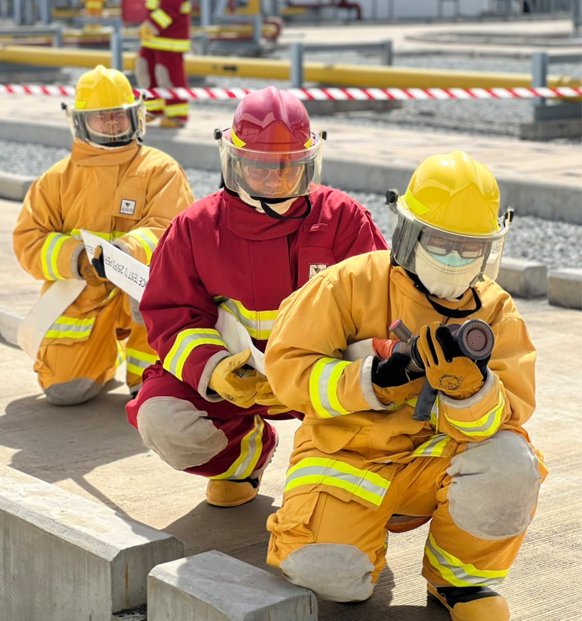
Safety Culture and Health Promotion Training
Occupational Safety: We place a strong emphasis on fostering a safety culture by fostering knowledge, raising awareness, and enhancing safety-related skills and capabilities among employees and contractors. The company conducts occupational health and safety training, in alignment with legal requirements and offers specialised safety courses tailored to specific job roles. Examples include training for confined space entry, electrical work, working at heights, basic first aid, Automated External Defibrillator (AED) usage, and Lock Out Tag Out (LOTO) procedures. In addition, we promote Behaviour-Based Safety (BBS) to reinforce safety awareness and encourage safe conduct among all employees.
Health Promotion: B.Grimm Power recognises that supporting employees’ physical and mental well-being is a key factor in ensuring safe working conditions. We conduct annual health assessments tailored to individual job-related risks and regularly evaluate employee health risks. Furthermore, we have implemented specialised programmes for employees operating in high-risk areas. For instance, personnel assigned to work in confined spaces must undergo a comprehensive pulmonary and respiratory health assessment. This process not only certifies their fitness for duty but also serves as a proactive health shield, leveraging diagnostic tools such as chest X-rays to screen for early-stage conditions, including Tuberculosis (TB) and other lung diseases. To broaden our preventative care, we provide annual influenza vaccinations for all employees, with discounts also available for their families, as this prevention not only helps reduce sick leave rates but also mitigates the risk of outbreaks within the organisation. Additionally, we organise health promotion activities, including Safety Week, Walk & Run events, an in-house gym facility, and Sport Day activities to foster a holistic approach to employee well-being. For more details, please refer to the "Our People" section.
Performance 2024
100% certified
All combined cycle co-generation power plants are certified1 under:
- Occupational Health and Safety Management System (ISO 45001:2018)
- Business Continuity Management System (ISO 22301:2019)
Zero
fatalities in employees and contractors
16,193 hours
Occupational Health and Safety training
for 1,108 employees in 2024
1 Covering combined cycle co-generation power plants that have been in commercial operation for at least 3 years for ISO 45001:2018 certification and at least 1 year and 6 months for ISO 22301:2019 certification.
2 A total of 1,108 employees completed the Environment and Safety training, of which 948 received specialised Occupational Health and Safety training.
B.Grimm Power continues to implement ongoing safety measures, including workplace inspections, process reviews, employee training in safe practices and continuous monitoring during operations, led by supervisors. As a result, there have been no fatalities among employees and contractors and no injuries among employees. However, an injury case involving a contractor was reported. The incident was thoroughly investigated by relevant parties and the Professional Safety Officer, and corrective actions were promptly taken. Preventive measures were implemented to prevent recurrence, and an accident investigation report was submitted to the relevant authorities. The affected contractor has returned to work and received legal compensation.
Continuous improvement of occupational health and safety management guidelines.
- Reassessed operational risks at power plants that could potentially impact business continuity, particularly emergency situations such as fires, chemical spills, floods and natural gas pipeline leaks. To address these risks, we have developed an integrated Emergency Response Plan covering potential incidents. Emergency rehearsal conducted regularly and evaluated by external consultants to ensure effectiveness and alignment with international standards. These rehearsals are carried out in collaboration with relevant regulatory authorities in the areas where our power plants are located, including industrial estate offices and local government agencies. Additionally, community representatives from surrounding areas are invited to observe the exercises. In 2024, the following emergency response drills were conducted:
Fire Emergency Response Drill
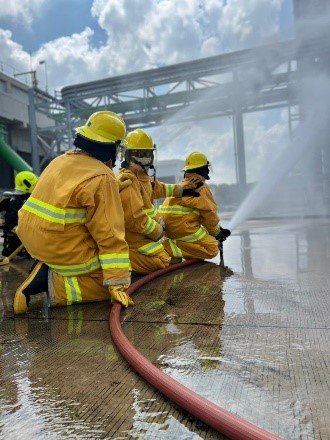
Chemical Spill Response Drill
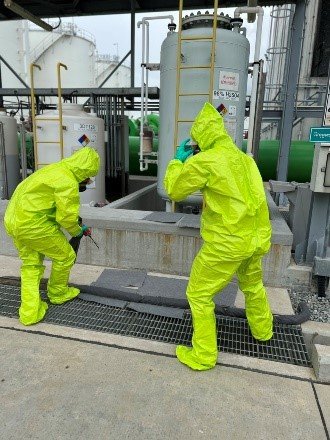
Natural Gas Pipeline Leak Response Drill
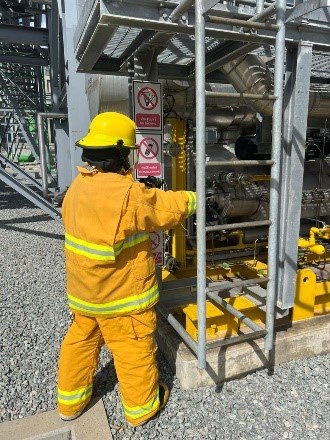
Flood Emergency Response Drill
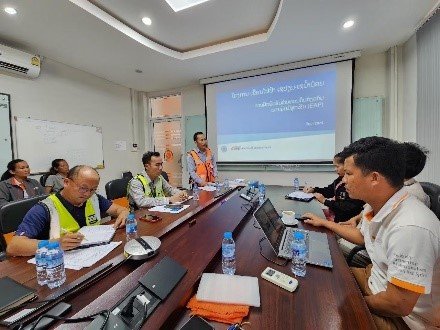
- Conducted regular inspections of workplace areas and working environments at all power plants at least once a month, and once every 3 months at the Bangkok Office. These inspections are carried out by the Occupational Safety and Health Committee of each power plant and the Bangkok Office. If any unsafe working conditions or hazardous environments are identified, the responsible parties must take corrective actions within a specified timeframe to ensure workplace safety.
- Performed annual occupational health and safety monitoring audit led by the Corporate SHE Department. In 2024, audits were conducted at 46 power plants. Key areas identified for improvement included enhancing the occupational health, safety, and environmental management system in preparation for ISO 45001:2018 certification in 2025. Examples of improvement measures include establishing a legal register, developing a training plan, and conducting management reviews. An issue related to the work permit system for ground-mounted solar power plants was also identified and has since been resolved.
- Integrated occupational health and safety considerations into the scope of power plant operations audits in 2024 as part of the internal audit plan, the Internal Audit Division focused on controls related to policy and procedure implementation, annual action plans, execution of planned activities, and monitoring and reporting to ensure alignment with relevant regulatory requirements. Occupational health and safety management at a solar rooftop power plant project in Thailand was reviewed, and internal control issues were identified. These findings were communicated to the responsible unit, with corrective measures scheduled and successfully completed within the specified timeframe.
- Reviewed past accidents and incidents, including potential risks from operations or unsafe work environments to develop preventive measures that protect employees, contractors, and all relevant personnel. Additionally, we create safety communication materials addressing key concerns, such as vehicle usage within power plant premises, accidents caused by equipment or machinery failure, fire hazards, chemical spills and accident recurrence prevention guidelines.
Training and promoting safety culture and well-being
- Conducted training in occupational health and safety practices tailored to individuals job roles to enhance employees’ skill and knowledge, accumulating a total of 16,193 hours. The training covered various aspects, including safety officer training, and workplace safety training such as electrical work, boiler operation, confined spaces entry, basic first aid, Automated External Defibrillator (AED) usage, and Lock Out/Tag Out (LOTO) procedures. Additionally, we extended our safety trainings to contractors and related parties to raise awareness of workplace occupational health and safety and reduce work accidents and incidents.
- Organised activities to promote a safety culture such as Safety Week events at each power plant, to raise awareness of workplace safety and encourage employee well-being while supporting the prevention and control of occupational health, safety, and environmental impacts. These activities also included training sessions, knowledge sharing, and experience exchanges on safe behaviour. In addition, health promotion activities were held, such as the 3-month “Walk for Health 2024” challenge to encourage physical activity and reduce office syndrome. Other initiatives included interactive activities like “Hazard Spotting” games, where employees identified potential hazards from illustrated scenarios.
- Communicated and promoted safety information on a monthly basis through electronic channels, focusing on relevant knowledge aligned with current issues to continuously enhance safety awareness among employees. Additionally, we introduced a LINE Official account as an additional communication channel to facilitate quick access to health and safety information. Through this platform, employees can submit questions, exchange knowledge, report potential safety-related incidents and accidents, consult with safety officers, and stay informed about updates and activities that support the company’s safety culture.
- Strictly controlled access is enforced for all work conducted within power plant areas. Personnel working within these premises are required to wear Personal Protective Equipment (PPE) and complete safety training conducted by each power plant’s safety officer. For high-risk tasks—such as working in confined spaces, at heights, with heat and sparks (hot work), or electrical systems—a work permit must be obtained using the designated form. In addition, the working environment in these areas is systematically monitored and inspected to ensure safety is maintained throughout the entire duration of the task.

